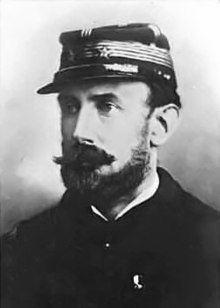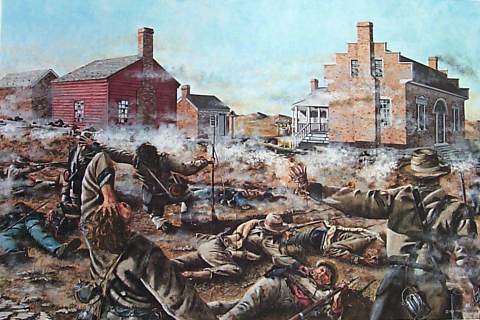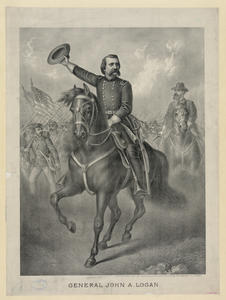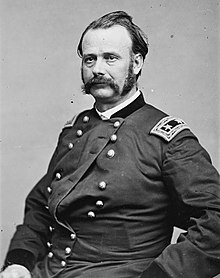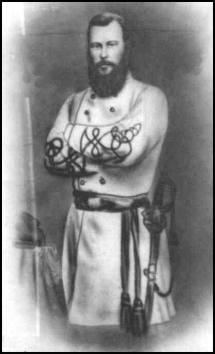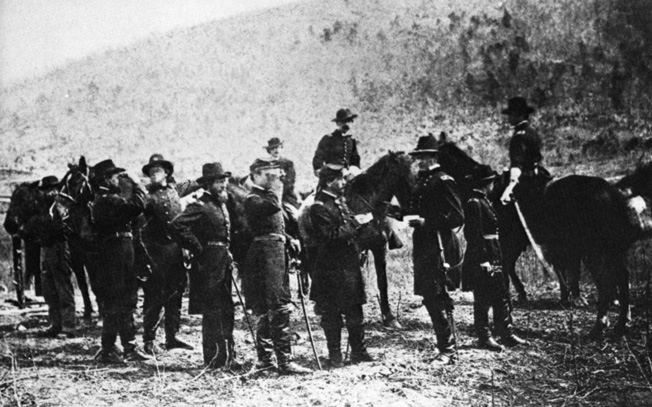Chapter Ninety-Two Day Two – Blue or Gray: Hooker Arrives
Chapter Ninety-Two
Day Two – Blue or Gray: Hooker Arrives
From "U.S. Grant - Hero of Three Wars" by John W. Eisenhower
Edison 1953
“Grant had ridden from the Padden House back to Peek’s Hill to observe the morning’s recommencement of battle. Ord and Blair were renewing the fight with Loring at Gadsden bridge and the adjoining fords. Black Jack Logan was taking time to prepare an assault that might stand some chance of breaking through Richard Taylor’s riparian defences…
Having moved from the Homestead it took Eugene Carr’s staff officer twenty minutes longer to find Grant than Carr had expected. By that time the popping of gunfire to his north east had caught Grant’s attention. At least one officer thought he could make out a screen of skirmishers on Hoke’s Bluff. It did not take the arrival of Carr’s staff officer for Grant to realise he was facing a flank attack, no doubt in force. Carr’s message confirmed that the rebels carried the “Hardee battle flag” – a white dot on a sky blue field with a white border. Knowing that the rebels captured the previous day were all from units believed to be attached to Bragg’s Army of Mississippi, Grant assumed that Hardee’s whole Army of Tennessee might be advancing on his flank…
The "Hardee Battle Flag" was commonly used throughout the Army of Tennessee
His first action was to detach Nathan Kimball’s division of Ord’s Corps from the attack on Blair’s Ford. Kimball was ordered to march to Glencoe with all possible speed and to place himself at General Carr’s disposal. Grant also sent a message to General Logan requesting one of his divisions be likewise dispatched. One of Grant’s newer staff officers expressed the concern that “denuding Logan’s attack of troops might render it ineffective”. Grant paused long enough to remove an unlit cigar from his mouth “Gentlemen we have the interior lines while the rebels are scattered and divided by the river. We would be fools not to take advantage of that”. That was as much direct instruction on the fighting of the battle as Grant’s staff officers were to get that day and more than they usually got. “He made up his own mind, and the staff got their first knowledge of what was to be done from his written orders. No living man knew of his plans until they were matured and decided.” (Colonel W R Rowleyof Grant's staff)…
While Grant’s orders were dispatched, something on the horizon caught Horace Porter’s eye. Beyond the Coosa and beyond the known rebel positions, further troops could be seen on the march southwards. Only a handful of Grant’s staff could make them out. Where they more rebels? Was it part of Hardee’s or Bragg’s command, or perhaps another as yet unidentified rebel command? Or could it possibly be some portion of Hooker’s army? In the early morning light no one could be sure. “It doesn’t matter. Shan’t change my plans one bit this morning, though I’m sure Bragg will change his” was the comment attributed to Grant…”
From “The Most Hated of Men – Braxton Bragg in the Civil War” by Grafton Lowe
University of Kentucky
“The advance of troops from the north was not missed by the Confederate cavalry. Buford reported to Bragg in person. Lawrence Graham’s cavalry was, in Buford’s opinion, merely a screen for a much larger Federal force. Shortly thereafter a substantial force of infantry could be seen in the distance from Bragg’s headquarters well to the rear of Loring’s position…
This was a critical moment in the battle. General Bragg was struggling to come to terms with the fact that some element of Hooker’s Army of the Cumberland was now in his rear and its vanguard would be in a position to attack the rear of the Army of Tennessee by midday, perhaps early afternoon at the latest.
Yet even now Hardee’s forces would be attacking Grant in the rear. Bragg did not expect the Federals to make any progress at Gilbert’s Ferry. The conflict in the centre between Loring and Sherman (now Blair and Ord) was simply a matter of fixing the Federal troops at the river. It was up to Hardee to win the battle against Grant, but Bragg felt it was not only possible to still win the battle, he felt he was on the cusp of doing so…”
From “The War Between the States” by Otis R. Mayhew
Sword & Musket 1992
“Some commentators, especially the “exiliados grises” historians of the late 1800s and of the 1920s and 30s, believed this is the point where the Confederate rebellion was lost. Bragg’s decision, to stand and fight both the Army of the Mississippi and what turned out to be the lion’s share of the Army of the Cumberland, would certainly end in catastrophe for the rebel cause in the west. However one cannot see how Bragg could possibly have achieved sufficient victories to defeat both Hooker and Grant.
Many of the exiliados grises theories focus around Bragg and Hardee winning sufficient battles, and holding out in the west until the November elections in the North, to ensure the defeat of Lincoln. This is certainly a theory one still hears from time to time in the University of Carlotta and the Keep. However most American historians now agree that, by the fall of 1863, this was an unachievable dream…”
From “Fighting Joe Hooker” by Herbert Walter
Buffalo 1999
“Hooker had regained some of his natural ebulliency. His men were very tired but if the sounds emanating from the south were anything to go by, the rebels and Grant had each other firmly by the throat. He grandly pronounced to his assembled generals, Meade, Richardson, Butterfield, Warren and Granger “No man will consider the day as ended, until the battle it brings has been won and the enemy before us defeated”…
Thomas’ XIV Corps was passing through the village of Norton. Lovell Rousseau’s division led the way, followed by J.J.Reynold’s division (Jackson had been left behind to lick his wounds). Hooker assigned Thomas the task of continuing south on the Norton Road towards Gilbert’s Ferry. Thomas' troops would therefore advance towards the rear of Taylor position.
Elements of Richardson’s XXI Corps, Hazen’s and Palmer’s divisions, were on the parallel Ridgeville Road, albeit slightly further back. Hooker’s intention was that Richardson’s troops would follow the road to the Gadsden bridge, thus sandwiching Loring’s troops between the two armies.
Granger’s full corps, Baird, Cox and Steedman, all followed Thomas on the Norton Road some distance to the rear. Hooker intended to deploy them flexibly as the moment required…”
From “The Life of General William J. Hardee - Teach Them How To War” by Christopher L. Pike
Bison 1965
“Hardee was visibly appalled by the dispatch he had just received from Thomas Churchill. Churchill’s Corps, after having marched all the previous day to the Coosa River, had received retrograde orders from General Bragg. Hardee had received no orders from Bragg as yet, nor was the implications clear – did Bragg intend that Hardee and Cleburne call off the attack or did he expect Cleburne to defeat the Federals on his own…?
Operating on exterior lines made communication between Bragg and Hardee difficult. However eventually orders arrived with Hardee. The attack was to continue – Cleburne was to break into the Federal rear alone…”
From “The Irish Corporal – The Life and Battles of Patrick Ronayne Cleburne” by James Fitzgerald Maguire
Trinity Press
“Withers and Stewart had keep their divisions moving forward. Carr's attempts to halt their advance had limited success. It was a simple matter of numbers initially. Cleburne had them and Carr didn’t. Nonetheless the timely deployment of Hovey’s division on the Union right, Brigadier George F. McGinnis’ and Colonel James Slack’s brigades, slowed the Confederate advance briefly…
It was on the Union left that Cleburne’s troops were making most progress. Withers’ troops were forcing Lawler’s brigades south and east. This was forcing Carr’s line away from Glencoe and contact with Ord and Blair, as Bragg had intended…
The intensity of this fight increased with the near simultaneous arrivals of Cleburne’s third division, Preston Smith’s, and Nathan Kimball’s division of Ord’s Corps. As Kimball’s lead brigade, Adolph Engelman’s, emerged from the hamlet of Glencoe Cleburne directed Preston Smith to throw the full weight of his division against the hamlet. Smith’s four brigades, including one led by President Lincoln’s brother-in-law, Benjamin Hardin Helm, raced towards Glencoe with their white and sky blue banners held high…”
From “The Battle of Coosa River” by Cornewall Jackson Baynard
Carlotta Press 1905
“General Bragg’s revised plan was to hold Gadsden bridge with Marmaduke’s division, Blair’s Ford with Mouton’s Salamnaders and Wharton’s Ford with Forney’s reinforced division. Taylor with Stevenson’s Division and the balance of M.L.Smith’s division would hold Gilbert’s Ferry.
Abraham Buford’s cavalry and Brigadier General Prince Camille Polignac’s Texas infantry division would have the dubious honour of holding the Ridgeville Road, near Bellevue House, until Churchill’s Corps could be recalled to their assistance.
It was a gamble that few Southron commanders would have made in Braxton Bragg’s place. General Hardee was scathing about Bragg’s decision to fight it out in his report to the Chief of Staff…”
Last edited:

